Spårväg City Line 7 accessibility upgrade: part 1Construction Only Award |
|
Project Team
Client: Trafikförvaltningen (the Transport Administration, Stockholm County Council)
Contractor: Skanska
-------------------------------------------------------------------------------------------------------------------------------------------------------------------------------------
Project summary
Tram Line 7 is currently in regular service between Kungsträdgården in Stockholm city and Waldemarsudde in South Djurgården. The (Spårväg City) tram system is planned to be expanded and link Lidingö with Stockholm city via Stockholm Royal Seaport, the new sustainable urban development in Frihamn and Värtahamn. The first stage of this expansion, assessed in accordance with CEEQUAL, is the accessibility upgrade of Tram Line 7 and the tram stops in South Djurgården. 12,000 new homes and 35,000 new workplaces are under construction in Stockholm Royal Seaport, and Spårväg City will supply most of the public transport services. In addition, South Djurgården is the world’s seventh largest entertainment centre with more than 14 million visitors annually. Visitor statistics for South Djurgården indicate that this number will continue to rise; hence Tram Line 7 is an important connection for Stockholm’s economy. |
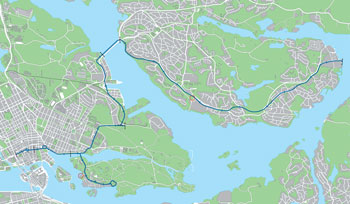 Spårväg City’s route and connection with Lidingöbanan after completion of the expansion from Sergels torg/T-Centralen in Stockholm city to Gåshaga brygga on Lidingö Spårväg City’s route and connection with Lidingöbanan after completion of the expansion from Sergels torg/T-Centralen in Stockholm city to Gåshaga brygga on Lidingö |
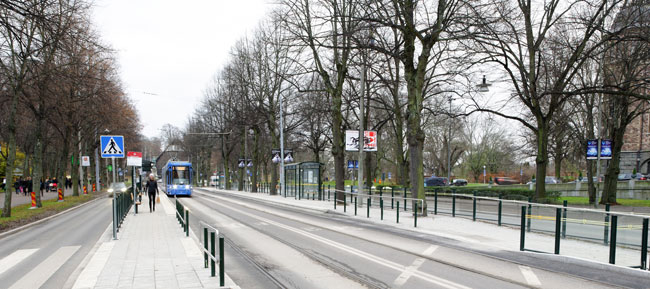
Accessibility-enhanced tram stop at Nordiska museet. (Photo by Kjell-Arne Larsson)
Challenges faced and Achievements
Project Management
 Collaboration meeting part 1, at the Nordic Museum, with representatives from the client, the designer and the contractor for greater innovation and sustainability. (Photo by Sylvester Holmström) Collaboration meeting part 1, at the Nordic Museum, with representatives from the client, the designer and the contractor for greater innovation and sustainability. (Photo by Sylvester Holmström) |
Collaborative project: The project has largely been conducted in collaboration between the two major stakeholders, namely the client, Trafikförvaltningen (the Transport Administration Stockholm County Council), and the contractor, Skanska. The project was procured as an explicit collaborative project, and the Transport Administration as client has collaborated with Skanska, the contractor, on the accessibility upgrade of Tram Line 7. Together they have been collaborating to find solutions that are environmentally and economically responsible, as well as taking into account health and safety. Project members have been committed to working towards common goals and to come up with innovative solutions. Environmental and sustainability issues have been prioritised in the project agenda through collaboration and the use of CEEQUAL. During the project regular collaboration meetings have been held between the project management groups of each organisation. |
Clear structures and procedures for working with environment and sustainability:
A part of the Transport Administration’s work has involved breaking down the environmental plan and checklist for the programme as a whole into a project-specific requirements list, which can then be used as a tool during further collaboration with the contractor. Project-specific procedures have been developed for product selection, chemicals and work with CEEQUAL. Regular environmental meetings/workshops have been held together with environmental officers from the contractor and the designer as well as regular status meetings and sessions to follow up the environmental work during actual production. Clear procedures and structures have facilitated the effort to meet set environmental standards.
People and Communities
| Improving accessibility: The project to improve accessibility on existing Tram Line 7 is in its entirety an element in a commitment to social sustainability which ensures that all passengers have access to and from both buses/trams and platforms. Part of this has involved building test platforms to assess the best design for the accessibility features. The test platforms were visited by the project staff and by the resource group in particular, which consisted of representatives from various disability organisations who provided their views on the necessary prerequisites to achieve satisfactory accessibility. The resource group was also invited to take a tram ride after the accessibility upgrade had been completed in order to evaluate the results. Part of the efforts to reach all passengers has involved a study of how children experience travelling by tram. This will form the basis for the future planning and design of tram facilities. |
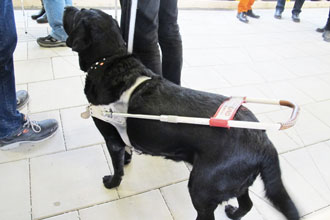 The test platform. (Photo by Kjell-Arne Larsson) The test platform. (Photo by Kjell-Arne Larsson) |
Third-party dialogue:
Another important element has been the ongoing dialogue with their stakeholders, both within the organisation at the Transport Administration itself and with the third parties and operators in the area where we are working. The project has distributed regular newsletters and organised meetings for local residents and businesses. The project has also worked closely with the transport operator to monitor how work on the upgrade is impacting passenger environments.
Within the project, the aim has been to achieve a high level of third party satisfaction. The target is to achieve 80% after the upgrade. A survey of perceived quality is carried out every month and from February 2015 local trains achieved 86% (compared to the other modes of transport: Metro 82%, rail 75%, bus 74%). For Tram Line 7, customer satisfaction stands at 93%, the highest level for any transport mode in the SL network. Regarding the production on Djurgården, no major complaints have been received, which the contractor has worked hard to ensure.
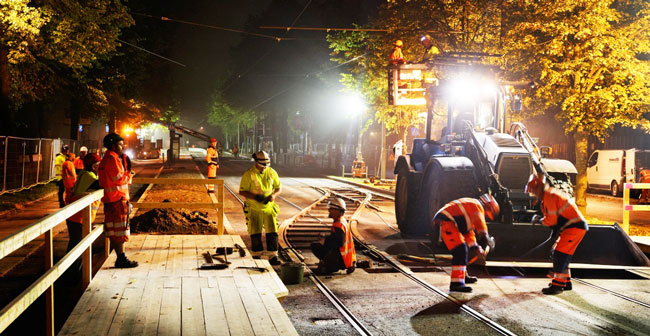
Installation of temporary tramway points at the Nordiska museet stop in autumn 2014. (Photo by Kjell-Arne Larsson)
Temporary tramway points:
The use of temporary tramway points has for many decades been a “forgotten technology” in Stockholm, one which the project has now revived. It has allowed tram services to be maintained during production to the benefit of both passengers and the construction team, and the latter has been able to perform its work with a higher level of safety and security. Passengers have been able to continue travelling by tram, and replacement bus services have been avoided, which has reduced the environmental impact of the project (emissions) as well as its cost.
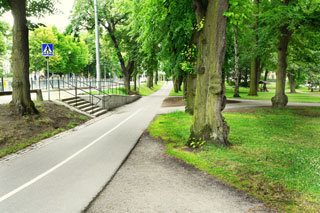 Accessibility ramp down to Djurgårdslätten at the Skansen stop. (Photo by Kjell-Arne Larsson) Accessibility ramp down to Djurgårdslätten at the Skansen stop. (Photo by Kjell-Arne Larsson) |
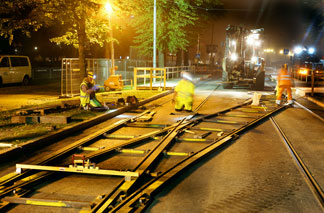 Installation of temporary tramway points at Nordiska museet in autumn 2014. (Photo by Kjell-Arne Larsson) Installation of temporary tramway points at Nordiska museet in autumn 2014. (Photo by Kjell-Arne Larsson) |
Ecology and Biodiversity
Tree protection: Transportation, waste and water: |
 Tree protection at the Gröna lund stop. (Photo by Anna Palmér) Tree protection at the Gröna lund stop. (Photo by Anna Palmér) |
To what extent did the use of CEEQUAL influence your project?
CEEQUAL as a tool has provided guidance in every phase of the project, providing traceability in all areas. Focus has shifted from constant checks to a desire and appreciation for continuous improvements.
|
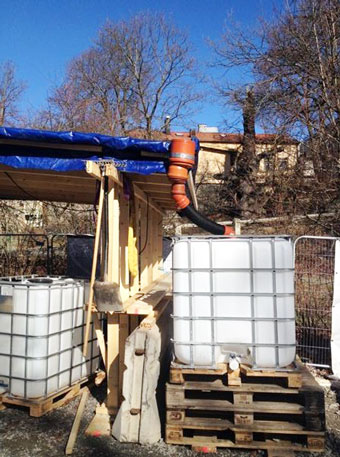 Rainwater collector. (Photo by Anna Palmér) Rainwater collector. (Photo by Anna Palmér) |

